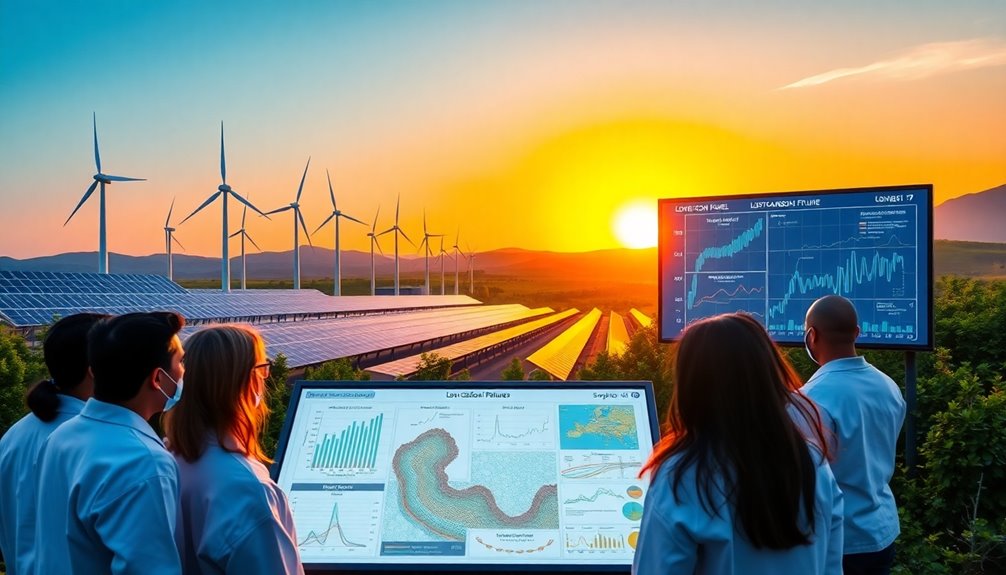Low-carbon fuels are vital for helping you meet net-zero targets, especially in hard-to-electrify areas like heavy-duty transport and aviation. They offer the energy density needed for a smooth transition away from fossil fuels, supported by technological advancements that improve efficiency and reduce emissions. Policies and regulatory frameworks promote their adoption, ensuring compatibility with renewable energy sources. This integration enhances system flexibility and reliability. There's much more to explore about their role in energy system modeling.
Key Takeaways
- Low-carbon fuels are essential for decarbonizing hard-to-electrify sectors, impacting integrated energy system models for net-zero targets.
- Technological advancements in biofuels and hydrogen significantly reduce greenhouse gas emissions, influencing modeling accuracy for energy transition scenarios.
- Policy frameworks like Low Carbon Fuel Standards drive market demand, which is vital for effective integrated energy system modeling towards net-zero objectives.
- The integration of low-carbon fuels enhances energy system flexibility, ensuring reliability and stability during the transition to greener energy sources.
- Economic growth and job creation from low-carbon fuel adoption can be modeled to forecast community impacts, highlighting socio-technical factors in energy transitions.

As the world grapples with the pressing need to combat climate change, low-carbon fuels emerge as a vital solution for reducing carbon emissions in sectors that are tough to electrify, like heavy-duty transportation and aviation.
These fuels play a key role in achieving net-zero targets by 2050, particularly when combined with carbon capture and utilization technologies. By providing necessary energy density, low-carbon fuels facilitate a gradual transition away from fossil fuels, making them economically viable compared to a rapid shift to renewable sources. Notably, ethanol's potential role in low carbon initiatives is recognized as essential for assisting in emissions reductions.
Low-carbon fuels are essential for achieving net-zero targets, offering a practical transition from fossil fuels while enhancing energy density and economic viability.
Technological advancements in fuel technologies, such as biofuels and hydrogen, support increased efficiency and lower carbon outputs. You'll find that low-carbon fuels already demonstrate significant reductions in greenhouse gas emissions compared to traditional fossil fuels, making them essential for decarbonizing hard-to-electrify sectors.
Moreover, policies like Low Carbon Fuel Standards promote the adoption of these fuels, ensuring they integrate smoothly into our energy systems.
Integrating low-carbon fuels enhances energy system flexibility, allowing for better compatibility with intermittent renewable sources. This flexibility addresses energy storage challenges, helping maintain grid stability during periods of high demand.
By contributing to a diversified energy mix, low-carbon fuels stabilize the energy landscape, ensuring reliability even as we transition to greener alternatives.
Beyond environmental benefits, using low-carbon fuels can stimulate economic growth. The creation of new energy infrastructures and job opportunities will bolster local economies.
As you consider the socio-technical factors involved in adopting these fuels, you'll recognize the importance of community engagement and policy support in driving successful integration.
Frequently Asked Questions
How Do Low Carbon Fuels Compare to Renewable Energy Sources?
When you compare low carbon fuels to renewable energy sources, you'll find that both play essential roles in reducing emissions.
Low carbon fuels can utilize existing infrastructure and provide high energy density, making them suitable for hard-to-electrify sectors.
However, renewables like solar and wind are increasingly cost-effective and produce minimal emissions during operation.
While low carbon fuels offer a transitional solution, renewables are the key to sustainable, long-term energy solutions.
What Are the Economic Impacts of Transitioning to Low Carbon Fuels?
Transitioning to low carbon fuels significantly impacts the economy.
You'll see job creation with an estimated 14 million positions by 2030 in clean energy sectors. As investments in this area triple to $4 trillion annually, GDP growth could increase by 0.4%.
Plus, lower risks associated with low-carbon investments can stabilize financial returns.
However, you should remain aware of potential job losses in fossil fuel sectors, requiring support for affected workers.
How Can Consumers Support Low Carbon Fuel Initiatives?
You can be a superhero for the planet by supporting low-carbon fuel initiatives!
Start by purchasing vehicles that run on biofuels or electricity, tapping into tax credits and subsidies to save money.
Join advocacy groups, vote for climate-friendly policies, and educate others about the benefits.
Attend public hearings to voice your support and push for infrastructure investments.
Every small action you take can help build a cleaner, greener future for everyone!
What Role Do Government Policies Play in Low Carbon Fuel Adoption?
Government policies play a crucial role in low-carbon fuel adoption by creating frameworks that incentivize innovation and investment.
You'll see initiatives like low-carbon fuel standards and tax credits that make alternative fuels more accessible and affordable.
Additionally, infrastructure investments support the development of necessary facilities and charging stations.
These policies not only encourage market-driven solutions but also aim for equity, ensuring that all communities benefit from the transition to cleaner fuels.
How Does Public Perception Affect Low Carbon Fuel Implementation?
When it comes to low carbon fuels, public perception's got a major role to play.
If you're excited about the benefits, you'll likely support policies that promote their use. On the flip side, concerns about safety, costs, and environmental impacts can dampen enthusiasm.
Engaging with communities and addressing their worries is crucial if you want to see widespread adoption.
Ultimately, positive perception can drive investment and innovation in cleaner energy solutions.
Conclusion
Incorporating low carbon fuels is crucial for achieving net-zero objectives, as they can significantly reduce greenhouse gas emissions across various sectors. For instance, a hypothetical case study in a city transitioning its public transport to hydrogen-powered buses demonstrates how low carbon fuels can lower emissions while enhancing energy efficiency. By integrating these fuels into energy system modeling, you can better visualize pathways to sustainability and make informed decisions that drive progress toward ambitious climate goals.









